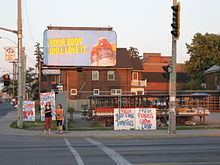Province Ontario | ||
 | ||
Ottawa street is a Lower City arterial road in Hamilton, Ontario, Canada. It starts off at Lawrence Road at the base of the Niagara Escarpment (mountain) and is a two-way street throughout, cutting through the Delta and Crown Point neighbourhoods and the City's North End industrial neighbourhood. It ends at Industrial Drive, the site of the Dofasco steel company. This used to be one of the east ends' mountain access roads - it continued south over the train tracks at Lawrence Road and quickly turned right towards the brick manufacturing plant once known as Hamilton Brick. It took several turns before joining what is now the Kenilworth Access near the old water reservoir entrance. Its routing up the mountain is fairly consistent with the current Kenilworth Access with one exception - another hair-pin turn at the top; not the traffic circle that is present now. It was because of these hair-pin turns that the Hamilton Street Railway discontinued bus service on this road in 1944, and why the City planned the "new" Kenilworth Access to the east which opened in 1957.
Contents
- Map of Ottawa St St Catharines ON Canada
- History
- Centre Mall reconstruction project
- Landmarks
- Communities
- Major roads that cross Ottawa Street
- Roads that are parallel with Ottawa Street
- References
Map of Ottawa St, St. Catharines, ON, Canada
History
Ottawa Street is known as the Fabric & Textile District and is Hamilton's "Decor Destination." It is the largest Fabric and Textile District in Canada and Hamilton's #1 tourist destination. It also hosts an annual Ottawa Street Streetfest, a shopping extravaganza that includes shopping deals, entertainment, foods, crafts; all a part of an outdoor street sale.
In 1862, The city had invested in the Great Western Railway but the government of Canada favoured the rival Grand Trunk Railway. Also, after the end of the Depression (1857–1862), the population dips downwards in Hamilton and the city could not meet the interest on its bonds, many of which were held by British investors. To save the city from its creditors temporarily, Henry Beasley removes the assessment rolls, thus preventing a levy of special tax. Foundries and machine shops associated with the Great Western Railway failed and several established wholesalers closed their accounts. Daniel C. Gunn's locomotive works went bankrupt, but the manufacturers of farm implements and stoves-the mainstays of iron foundries- were able to weather the crisis. Those owned by Dennis Moore and the Copp brothers endured, but their employees suffered wage cuts and layoffs. Canadian patent laws and the underemployed workers skilled in machinist trades lured an important new industrial enterprise from the U.S.A.- the manufacture of sewing machines by Richard Wanzer. From this development there evolved the ready-made clothing industry, which William Eli Sanford introduced locally. The Textile District evolved in East Hamilton, centered on Ottawa Street and boomed during the First and Second World Wars. It's a thriving district today.
In 1913, Procter & Gamble Manufacturing Company (based in Cincinnati, Ohio) purchased 7 acres (28,000 m2) of land and 2 acres (8,100 m2) of water on the south side of Burlington Street between Depew and Ottawa Streets. This event marked the beginning of Procter & Gamble's operations outside of the United States. In 1914, Construction started on the Procter & Gamble Hamilton plant, which cost $1 million and consisted of seven buildings: the Crisco building, the boiler house, the gas plant, the soap building, the hardening plant, the kettle and glycerin house, and the machine shop. By 1915, Procter & Gamble officially opens Hamilton plant, employing 75 workers who made six different products.
Hamilton became the birthplace of the Tim Hortons chain in 1964. The original store ("Store #1") still operates on Ottawa Street today. Ron Joyce, was Tim Horton's partner and first franchisee for his Canadian donut chain.
Centre Mall reconstruction project
Centre Mall owners announced plans for a 23-building super centre on the property on Barton Street East. Cost is estimated to be around $100-million and will take up 700,000 square feet (65,000 m2) of retail space. This will end up being the largest redevelopment project in the history of Hamilton's east-end. The overhaul will take about two-and-a-half years to complete but the bulk of the work is expected to be done by the end of the summer of 2008. Some new buildings will go up before the enclosed mall is torn down. The redevelopment of Centre Mall is transforming the entire neighbourhood from Ottawa to Kenilworth Avenue. The $100-million investment in the mall has boosted Ottawa Street North - already the city's No.1 tourist destination. The garment district has also morphed into a holistic home decor destination area, complete with lighting, antique, design & glass stores. The Ottawa Street B.I.A. had the most application and grants under the commercial property improvement program in 2007 with thirty three and it had an effect on the property values and real estate activity in the district.
Landmarks
Note: Listing of Landmarks from North to South.
Communities
Note: Listing of neighbourhoods from North to South
Major roads that cross Ottawa Street
Note: Listing of streets from North to South.
Roads that are parallel with Ottawa Street
Note: Listing of streets from West to East.
